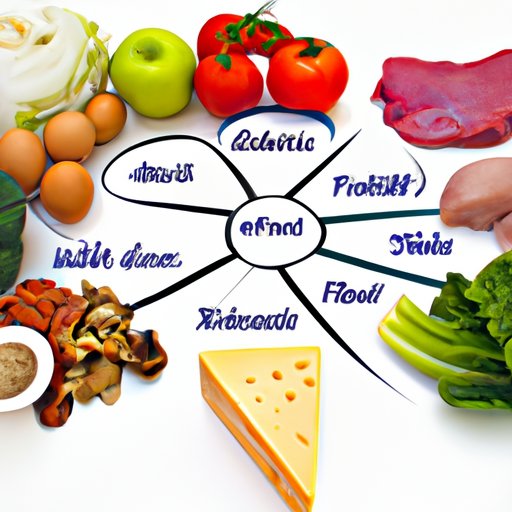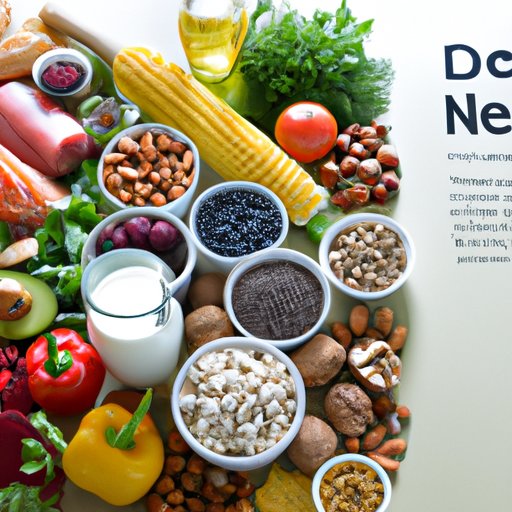Introduction
Eating a balanced diet is one of the most important aspects of good health. A balanced diet consists of all the essential nutrients, vitamins, minerals, and other compounds that our bodies need to function properly. It can help us maintain a healthy weight, reduce our risk of certain diseases, and provide us with energy throughout the day. But what exactly constitutes a balanced diet? And what are the main food groups that make up a balanced diet?
Exploring the Different Food Groups of a Balanced Diet
When it comes to creating a balanced diet, there are five essential food groups that should be included: grains, fruits, vegetables, dairy, and protein. Each of these food groups provides different nutrients and benefits to our bodies.
The Five Essential Food Groups for Optimal Health
Grains: Grains are a great source of carbohydrates and fiber, which are essential for providing us with energy and keeping our digestive system working properly. Examples of grains include wheat, oats, barley, quinoa, and corn.
Fruits: Fruits are packed with vitamins, minerals, antioxidants, and fiber. They can help boost our immune system and protect us from disease. Examples of fruits include apples, oranges, bananas, strawberries, and blueberries.
Vegetables: Vegetables are a great source of vitamins, minerals, and fiber. Eating a variety of vegetables can help reduce our risk of chronic diseases and provide us with essential nutrients. Examples of vegetables include carrots, broccoli, spinach, kale, and tomatoes.
Dairy: Dairy products are a great source of calcium, protein, and other essential nutrients. Dairy products such as milk, cheese, and yogurt can help keep our bones strong and our muscles healthy.
Protein: Protein is essential for building and repairing muscle, and it can also help to boost our metabolism. Examples of protein-rich foods include lean meats, fish, eggs, beans, nuts, and seeds.
Other Food Groups to Consider
In addition to the five essential food groups mentioned above, there are also some other food groups that you may want to consider incorporating into your diet. These include legumes, nuts and seeds, and healthy fats.
Legumes: Legumes are a great source of plant-based protein, fiber, and other essential nutrients. Examples of legumes include lentils, peas, beans, chickpeas, and peanuts.
Nuts and Seeds: Nuts and seeds are an excellent source of healthy fats, protein, and fiber. Examples of nuts and seeds include almonds, cashews, walnuts, sunflower seeds, chia seeds, and flaxseeds.
Healthy Fats: Healthy fats are essential for maintaining heart health and providing us with energy. Examples of healthy fats include avocados, olive oil, coconut oil, and nut butters.

Creating a Balanced Diet with the Six Major Food Groups
Now that we’ve explored the different food groups that make up a balanced diet, let’s take a look at how to create a healthy eating plan. Here are some tips for making sure that you’re incorporating all of the major food groups into your diet.
A Guide to Healthy Eating: Understanding the Main Food Groups
Before you start planning your meals, it’s important to understand the different food groups and how they fit into a balanced diet. The best way to do this is by familiarizing yourself with the USDA’s MyPlate guidelines. MyPlate is an easy-to-follow guide that divides the plate into four sections: fruits, vegetables, grains, and proteins. It also recommends drinking low-fat or fat-free dairy products and limiting added sugars, saturated fats, and sodium.
The Benefits of Incorporating the Main Food Groups into Your Diet
Incorporating the six main food groups into your diet can have many benefits. Eating a variety of fruits, vegetables, grains, dairy, proteins, and healthy fats can help ensure that you’re getting all the essential nutrients, vitamins, and minerals that your body needs. A balanced diet can also help you maintain a healthy weight, reduce your risk of certain diseases, and provide you with energy throughout the day.
How to Make Sure You’re Eating All the Right Food Groups for a Balanced Diet
Once you’ve familiarized yourself with the different food groups, it’s time to start planning your meals. Start by making sure that you’re including at least one item from each of the six major food groups in every meal. For example, you may have a bowl of oatmeal with blueberries for breakfast, a salad with grilled chicken for lunch, and a stir-fry with quinoa and vegetables for dinner. You should also try to limit processed and sugary foods, and opt for whole foods whenever possible.
Conclusion
Creating a balanced diet with the six main food groups is an important part of maintaining good health. By understanding the different food groups and incorporating them into your meals, you can ensure that you’re getting all the essential nutrients, vitamins, and minerals that your body needs. Eating a variety of fruits, vegetables, grains, dairy, proteins, and healthy fats can help you maintain a healthy weight, reduce your risk of certain diseases, and provide you with energy throughout the day.
Summary of Key Points
• A balanced diet consists of all the essential nutrients, vitamins, minerals, and other compounds that our bodies need to function properly.
• There are five essential food groups for optimal health: grains, fruits, vegetables, dairy, and protein.
• Other food groups to consider include legumes, nuts and seeds, and healthy fats.
• Eating a variety of foods from the six major food groups can help ensure that you’re getting all the essential nutrients, vitamins, and minerals that your body needs.
• Limiting processed and sugary foods and opting for whole foods whenever possible can help you create a balanced diet.
Final Thoughts on Creating a Balanced Diet
Creating a balanced diet with the six main food groups is an important part of maintaining good health. By understanding the different food groups and incorporating them into your meals, you can ensure that you’re getting all the essential nutrients, vitamins, and minerals that your body needs. Eating a variety of fruits, vegetables, grains, dairy, proteins, and healthy fats can help you maintain a healthy weight, reduce your risk of certain diseases, and provide you with energy throughout the day.
(Note: Is this article not meeting your expectations? Do you have knowledge or insights to share? Unlock new opportunities and expand your reach by joining our authors team. Click Registration to join us and share your expertise with our readers.)
